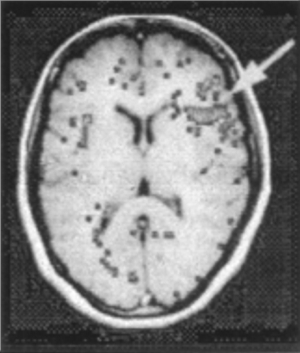 | Fig. 47: Brain scan of a person with frontal lobe epilepsy. Arrow points to the focus of seizure activity. [Image reproduced with permission from Seeck etal (1998) Electroenceph. Clin. Neurophys. 106, 508-512. |
Epilepsy affects approximately 1% of the population. Making it one of the most common neurological diseases. Epilepsy can strike at any time of life—from infancy to old age. While epilepsy varies widely in type and all forms of this disorder are characterized by recurring seizures resulting from abnormal cell firing in the brain. In approximately 30% of cases epilepsy is caused by such events as head trauma, tumor, stoke or infection. In those cases for which there is no known cause, recent evidence suggests there may be genetic predisposition for developing the disease.
It is an autosomal recessive disorder that has been linked to mutation of the gene EFM2A found on chromosome 6. Much progress has been made in narrowing down regions of chromosomes associated with different forms of epilepsy. With this effort, scientists continue to expand the list of genes involved in seizure disorders. Animal models of epilepsy also contribute to our understanding of electrical brain disturbances. By focusing on the genetic basis for epilepsy, scientists hope to develop more effective anticonvulsive treatments and, possibly, gene replacement therapies for seizure disorders such as Lafora disease.
 Prof. Dr. Sohan Raj Tater
Prof. Dr. Sohan Raj Tater
 Doctoral Thesis, JVBU
Doctoral Thesis, JVBU